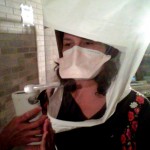Man is it hot out here. As the site HSO (Health and Safety Officer), we hear and utter those words quite frequently during the summer. Working outside in 90 degree temperatures with high humidity levels is anything but comfortable. Who doesnt look forward to the end of the work day when you can escape to an air conditioned environment with a cold drink or jump into the pool?
Its not just unpleasant -- working in hot, humid temperatures can be very dangerous. If you dont take extra care to rest and hydrate you can subject yourself to heat cramps, heat exhaustion, and the deadly heat stroke. So what can you do to protect yourself in hot, outdoor conditions while continuing to work.
As an experienced Health and Safety professional and working on construction and hazardous waste sites, I make an extra effort to see to it that there is plenty of water and electrolyte drink on hand before the work day begins. Throughout the day, I check on workers to see if any are exhibiting heat-related symptoms. Frequent breaks in a cool, shaded location and hydration (whether you feel thirsty or not) with water and electrolyte drinks are your first and best defenses against heat-related illnesses.
Its not just construction workers that need to aware of the affect of heat as they work anyone subjected to a continuous, hot working environment should keep heat-related illness prevention in mind. One of my most memorable projects was a cleanup of an abandoned chicken processing plant in the height of summer heat. The owner had walked away from the plant after the power had been cut off due to non-payment of the bills and there were several tons of chicken in various stages of processing in the freezers. Of course when the power gets cut, the freezers do not remain cold for very long. The odor caused by the decomposing chickens created quite a challenge for determining the proper personal protective equipment. Ultimately, the work on this project was performed in Level B (supplied air respiratory protection) with PVC suits as our protective clothing to block permeation of the odor.
Prevention of heat-related illnesses for the cleanup workers was a one of the focuses in our pre-project planning as the project began in July and continued through summer into the early fall. Because of the hot, humid temperatures and the heat-retaining PPE, we set a limit of 45 minutes for a group of workers who were then relieved after that time period by another group of workers. The first group would go through the decontamination process followed by a shower and rest in an area where we had assembled a tent to provide shade. Despite the challenges, we made it through this hot and truly disgusting project without any workers suffering from heat-related illness. In fact, this long-term and highly publicized remediation project was inspected by OSHA where portions of the project layout and performance were videotaped for use in OSHA training How-Tos!
Symptoms of Heat-related Illness
These indicators can, but do not have to, begin in progression starting with heat rash, heat cramps, heat syncope, heat exhaustion, and heat stroke.
Heat rash is a skin irritation caused by excessive sweating during hot, humid weather. In high humidity, the sweat does not evaporate quickly from your skins surface, and as clothing rubs against the wet skin, irritation can develop resulting in a rash.
Heat cramps are involuntary muscle spasms within the large muscles of your body. Heat cramps typically occur in the thigh, core, and arm muscles.
Heat syncope is a fainting or dizziness episode that can occur as a result of dehydration or lack of acclimation.
Heat exhaustion is the bodys response to loss of water and salt usually as a result of excessive sweating. Symptoms include heavy sweating, extreme weakness or fatigue, dizziness, clammy moist skin, muscle cramps, elevated temperature, and fast, shallow breathing.
Heat stroke is a medical emergency. As the body temperature rises, the sweating mechanism fails and the body is not able to cool down and control its temperature And, beware, this severe reaction can happy quickly: the body temperature can rise to 106 degrees within 10 to 15 minutes! Without emergency treatment, heat stroke can cause death or permanent disability. Symptoms of heat stroke include hot, dry skin or profuse sweating, hallucinations, throbbing headache, high body temperature, confusion/dizziness, and slurred speech.
What should you do if you start to experience any of these symptoms?
First of all, take a break. Move to a cool, shaded area and drink plenty of non-alcoholic, caffeine-free liquids. If possible take a cool shower or dip an article of clothing in cool water and place on your body. If you are suffering from heat rash do not apply wet clothing instead dry off and remain in a cool area until the sweating ceases. Resume work only after your body has cooled to normal temperature.
It is very important for Supervisors and Health and Safety Officers to keep a close watch on workers especially on hot, humid days and to allow them (as well as require them) to take frequent breaks. Workers exhibiting any of the symptoms listed above should be removed from the work area and instructed to take a break in a cool, shaded area and to drink water or an electrolyte drink.
How do you keep your cool on hot, humid days?












